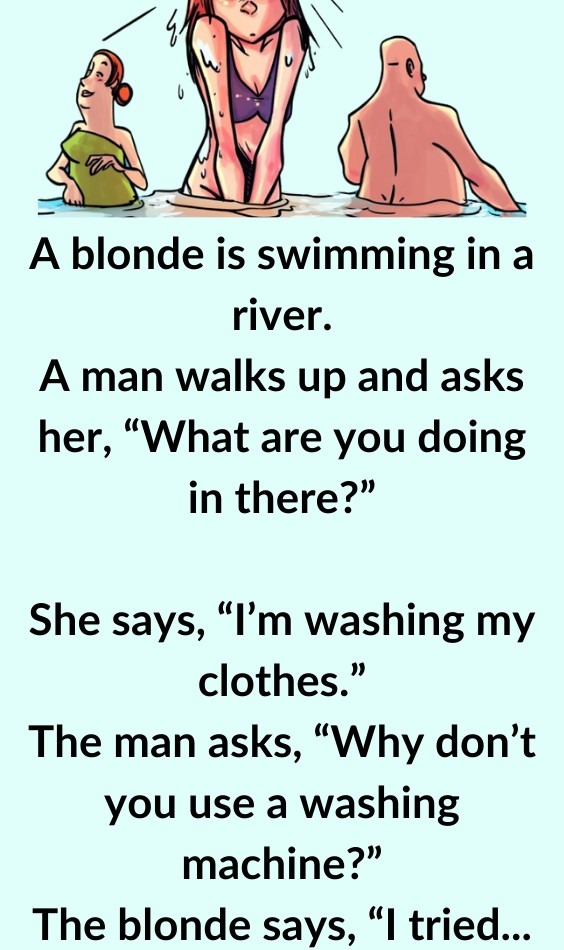A blonde is swimming in a river.
A man walks up and asks her, “What are you doing in there?”
She says, “I’m washing my clothes.”
The man asks, “Why don’t you use a washing machine?”
The blonde says, “I tried that, but it was too dizzy.”
This joke is a classic example of humor based on the stereotype of blondes being naïve or lacking common sense. While such jokes can be controversial, they remain a staple of popular culture and are often meant as lighthearted entertainment.
Structure and Analysis of the Joke
The joke is built around a short dialogue between two people—a blonde who is in a river and a passerby who questions her actions. It begins with an unusual situation: a woman is standing in the river, washing her clothes. This alone might seem odd in modern society, where washing machines are the standard way to clean clothes.
The humor lies in the blonde’s response when the man asks why she doesn’t use a washing machine. Instead of giving a logical reason, she replies that she tried but got “too dizzy.” This punchline is funny because it implies that she misunderstood how a washing machine works. Instead of simply putting clothes in the machine and letting it do the work, she seems to have physically gotten inside and spun around with the laundry, leading to dizziness.
Why the Joke Works
Expectation vs. Reality – The setup creates an expectation that the blonde is washing her clothes in the river out of necessity or preference. The punchline subverts this expectation by revealing an absurd misunderstanding.
Stereotypical Humor – The joke plays on the common stereotype that blondes struggle with logical reasoning. While this is a generalization, it is a trope frequently used in humor.
Absurdity and Imagery – The idea of someone getting inside a washing machine and becoming dizzy is ridiculous, which adds to the humor. The mental image of this scenario enhances the comedic effect.

Variations and Cultural Context
This joke is part of a broader category of “blonde jokes,” which have been around for decades and often depict blondes as lacking common sense in everyday situations. However, variations of this joke could be adapted to different characters or groups, replacing the blonde with someone else known for being inexperienced or clueless.
Ultimately, the humor in this joke comes from its playful exaggeration of misunderstanding, making it a simple yet effective piece of comedic storytelling.
Conclusion
This joke, like many others in the “blonde joke” genre, relies on exaggeration and misunderstanding to create humor. At its core, it plays with the contrast between expectation and reality—while we assume that the woman is washing her clothes in the river for a practical reason, her response completely subverts logic in a humorous way. The joke is structured to set up a simple yet effective punchline that delivers an unexpected twist, making it easy to understand and amusing.
The humor in this joke comes from the absurdity of the blonde’s misunderstanding of how a washing machine works. The idea that she physically got inside the machine and became dizzy suggests an extreme level of confusion, which is what makes the joke funny. The mental image of someone tumbling around inside a washing machine adds an extra layer of visual humor, making it even more effective.
Although blonde jokes are based on a stereotype, they have been a part of popular culture for decades. These jokes often depict blondes as lacking common sense, which, while an unfair generalization, has become a widely recognized comedic trope. It is important to acknowledge that humor based on stereotypes can sometimes be seen as offensive, but in many cases, such jokes are told in a lighthearted manner without any real intent to demean.
Beyond its reliance on stereotype, this joke also highlights how misunderstandings and misinterpretations of everyday objects or situations can be a great source of humor. Many classic jokes use similar techniques—taking something familiar and twisting it in an unexpected way to create laughter. The idea of someone mistaking a washing machine for something they need to be physically inside is a perfect example of how humor can arise from a mix of literal thinking and absurd conclusions.

In a broader sense, this joke exemplifies the universal appeal of simple, easy-to-follow humor. It does not rely on complex wordplay, cultural references, or deep thought to be funny. Instead, it presents a straightforward situation with a surprising and exaggerated response, making it accessible to almost anyone. The joke is effective because it plays on basic human experiences—everyone is familiar with washing machines, and the thought of someone misusing one in such an extreme way is inherently amusing.
Ultimately, humor is subjective, and different people may find this joke funnier than others. However, its simplicity, structure, and absurdity make it a classic example of how humor can be derived from unexpected twists and playful misunderstandings. Whether one finds blonde jokes amusing or outdated, this particular joke serves as an interesting study of comedic structure and the power of subverting expectations for a laugh.

















